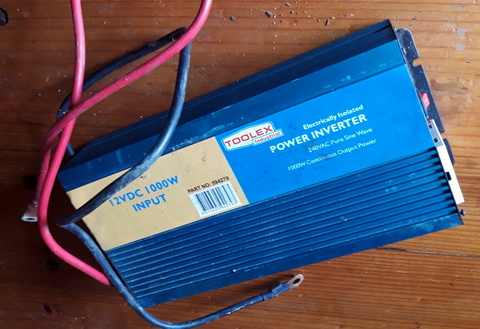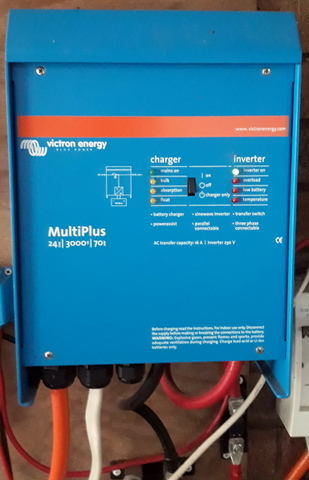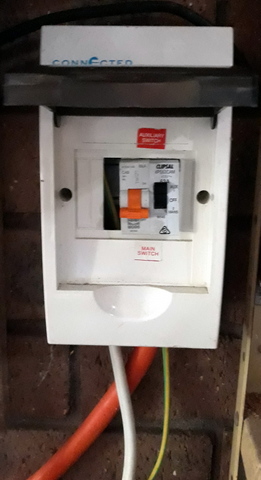The inverter, in a sense, is the heart of our system, it takes the energy produced by the solar panels and stored in the batteries and turns it into something that can be used to run the entire house. An inverter takes DC current, in our case 24 volts DC, and turns it into 240vAC, allowing mainstream appliances and lighting to be used with an alternative energy system.
I have fooled around with inverters before as part of our old 12 volt system, going from 12vDC to 240vAC, but most of the old house system was built around 12 volt lighting and appliances so the inverter was for small and specialised gear not available in 12 volt. More about our original 12volt system including the inverters can be found here.

All that had to change when we went with the new system, because it was designed to operate the house as it is, using the standard 240 volt system wired in when the house was built. Needless to say the wiring up of a built in inverter is not something I could do, it needed to be done by someone with electrical qualifications and experience in this area.
The discussion around how big an inverter to get (ie how many watts at 240v it could supply) was interesting. There are two main things we needed to know when sizing our inverter and the first one was – how much power were we likely to want at any one time? We just looked at the sorts of appliance we would run regularly and then worked out the one which used the most power. We found the dishwasher at about 1800 watts maximum was the most energy hungry appliance, but we still needed enough energy over that to continue to run lights, the fridge, freezer etc at the same time.

We sized our inverter at 3000 watts to be able to do what we wanted to, but if we run the microwave or the sandwich toaster at the same time it will crash the system, but more on that later. So once we knew what we wanted to run it was then a case of asking how much energy the system could supply. In our case it was a moveable feast and I added more panels in a couple of steps until the system has a nominal generation capacity of 2500 watts total although in reality it produces somewhat less than that at any one time.
At this point I would like to mention that we left three things off the new system so that they draw directly from the grid due to their high power draw but low usage rate ie we don’t use them much, but when we do they really suck power! These items are –
- The air conditioner,
- The electrical boost on the solar hot water system,
- A single 15amp socket in the garage which I use to power a small electric (stick) welder.
The inverter reads the power in the batteries and the sucks it out to power whatever it is we want at 240 volts. Obviously it can’t do this indefinitely or the system will run out of power, but what does that look like? Basically the inverter reads the battery voltage and when the voltage from our 24 volt system drops below 20 volts the system shuts down, and that is exactly what it sounds like! All power coming to the house from the inverter stops.
Thankfully, because there are some lights which were part of the original system and are still connected directly to the batteries via the 24vDC to 12vDC converter, when the system shuts down we still have some lights. And when we were first getting used to the system we shut it down A LOT! It still happens occasionally if we do something stupid but we are much better than we used to be.

The inverter does have the capacity to remain connected to the grid, and switch across to the automatically and seamlessly (most of the time, occasionally there is a glitch that will shut the system down even if the inverter is operating on back-to-the-grid mode). There is a black switch in the switch box next to the inverter which allows us to take the entire off grid system off line and go back on grid full time. The second (orange) switch allows us to be totally off grid (down) or have the option for the inverter to switch us back to the grid if needed (up). The problem is if the inverter is left in the “auto back to the grid mode” it will consume a small amount (20w – 40w 240vAC) of power from the grid in maintaining the link. Because of this, in mostly I leave the switch in the “off grid” mode.
Maintaining us in off grid mode means that we occasionally have accidents if the weather is not good for charging but I keep tabs on the batteries through the MPPT phone app and change over as required. The inverter has worked well since installed, with the exception of the aforementioned glitch that will occasionally shut the power down instead of going back on the grid.
Other articles in this series -
Our Off Grid Adventure - An overview
Our Off Grid Adventure - The Batteries
Installing the 24 vDC to 12vDC converter



